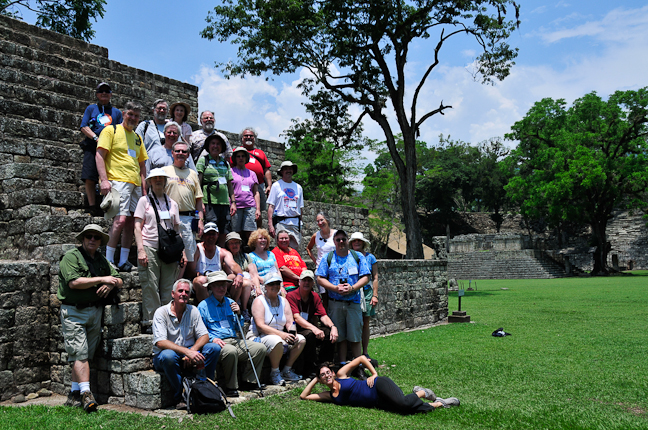- About MAA
- Membership
- MAA Publications
- Periodicals
- Blogs
- MAA Book Series
- MAA Press (an imprint of the AMS)
- MAA Notes
- MAA Reviews
- Mathematical Communication
- Information for Libraries
- Author Resources
- Advertise with MAA
- Meetings
- Competitions
- Programs
- Communities
- MAA Sections
- SIGMAA
- MAA Connect
- Students
- MAA Awards
- Awards Booklets
- Writing Awards
- Teaching Awards
- Service Awards
- Research Awards
- Lecture Awards
- Putnam Competition Individual and Team Winners
- D. E. Shaw Group AMC 8 Awards & Certificates
- Maryam Mirzakhani AMC 10 A Awards & Certificates
- Two Sigma AMC 10 B Awards & Certificates
- Jane Street AMC 12 A Awards & Certificates
- Akamai AMC 12 B Awards & Certificates
- High School Teachers
- News
You are here
Maya Geometry in the Classroom
(Editors' note: Para acceder a una versión en español de este artículo, haga clic aquí.)

Figure 1. 2011 MAA Study Trip participants in Copan, Honduras. Photo by John Wilkins, used with permission.

Figure 2. Maya ruins in Copan, Honduras.
Photo by Cynthia (Woodburn) Huffman, 2011.
Almost every year since 2003, the MAA has sponsored a study trip to a location of mathematical interest, such as Greece, Egypt, and China. The 2011 study tour had an emphasis on Maya mathematics and included sites in Guatemala and Honduras. Although the timing of the trip coincided with interest in the Maya long count calendar system and the end of a cycle in the year 2012, the group was also exposed to other information that has not received as much publicity and is not as well known. The focus of this article is on some of that information, namely Maya geometry and ways it can be used in the mathematics classroom. (For more information on Maya calendars, check out the Convergence articles “Maya Calendar Conversions” and “Maya Cycles of Time.”)
The 2011 MAA study tour was organized through the Maya Exploration Center with guide Christopher Powell. Powell (seated at far left in the first row in Figure 1 above) is an archaeologist with over twenty years of field experience. In addition to giving onsite explanations of Maya ruins, Powell presented several lectures to the group. One of these included material from his 2010 PhD dissertation, The Shapes of Sacred Spaces, in which he introduced how the Maya used ratios in their art and architecture, as well as their ingenious way of using a knotted cord to form right angles.
In this article, we start with some background information on the Maya and then explain different ways that the Maya used geometry, going into detail on how the Maya formed right angles and rectangles with sides in various ratios by using knotted cords. Animations and videos created by the first author are included to illustrate the processes. The article concludes with related classroom activities that are tied to the Common Core Standards.
John C. D. Diamantopoulos (Northeastern State University) and Cynthia J. (Woodburn) Huffman (Pittsburg State University), "Maya Geometry in the Classroom," Convergence (August 2013), DOI:10.4169/convergence20130801




